How To Blend Room Treatments
Let’s get this out there: Many AV enthusiasts need to consider the aesthetics of a room when decorating. Sure, their TV will be at the perfect height, speakers perfectly positioned, and subs are in optimal positions. Room treatments? Heck yeah, make ’em as big as possible and put them everywhere. Who cares if they look like big ole black boxes on the wall? Well, maybe the other people you live with care. So that’s why I will teach you how to blend room treatments into your space. Let’s discuss.
So Why Bother Blending Room Treatments?
Only some (lucky) people have a partner, spouse, or roommate who wants their room dominated by significant (and arguably ugly) room treatments. Sure, it will make the room sound better, but sometimes one needs to compromise.
I have a dedicated space for my gear, and I wanted to blend the room treatments into my Manland so that they didn’t become the focal point of my room. So how did I do it? Some creativity and some help from Google. And guess what? It didn’t cost a ton!
Colored/Patterned Fabrics Over Sound Treatments
So this is one of the easiest ways to add some pizazz to your room treatments and help to blend them with your decor. Most companies, like Gik Acoustics, offer room treatments in various colors, patterns, and finishes. For example, adding a splash of color that matches a sofa, cushion, or rug can blend room treatments.

Adding a cool pattern or finish is also a great way to add visual interest to a panel. Most fabric stores sell lots of fabrics that are acoustically transparent. How do you know? Easy, put it close to your mouth and blow through it. If air passes through easily, so will sound waves. Or you can use my go-to, Guildford of Main, and get some premium fabric for your DIY panels.
Printed/Art Panels As Sound Treatment
So printed panels are one of my favorite recommendations for blending room treatments. But, again, our friends at GIK Acoustics offer a variety of panels that can be printed with stock photos they provide or with your custom artwork.
Printed panels allow you to choose the artwork on your walls or have images of family or other memories. This idea could be a great way to hide an acoustic panel in your room and add to the beauty of your room.
But if DIY is your thing, no worries. Companies like Spoonflower have on-demand printed fabrics from artists worldwide and your custom work. So you can upload your non-copyrighted image and have them print away.
But a word of caution. Printed panels are not an exact match for the original image. It is impossible to get color as vivid as it appears on a screen. But my editor has several printed panels in his home theater and says they look great.
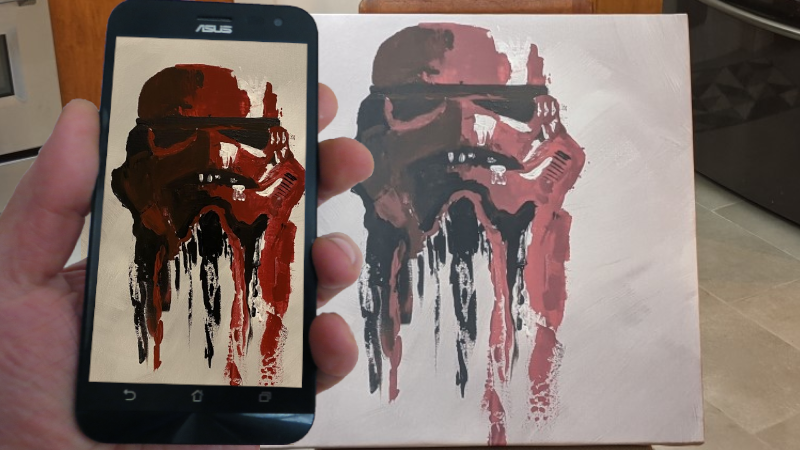
Shaped Panel
Shaped panels are one of my favorites for blending room treatments into your space. I didn’t consider making hexagons or other shaped panels when I built my panels. Sure, they are more challenging to make and stretch fabric over. But it’s easy to do if you are handy and can set angles on your miter saw. So I looked up a handful of online woodworking angle calculators and quickly found angles for various shapes.
And if you don’t have a DIY bone in your body? Well, guess what? Most acoustic panel companies sell their panels in various shapes and sizes. So if you want hexagons, you can have hexagons! Or you can take square ones and orient them, so they are diamonds. You can even blend various shapes and colors into a cool collage. Your only limit is your creativity!
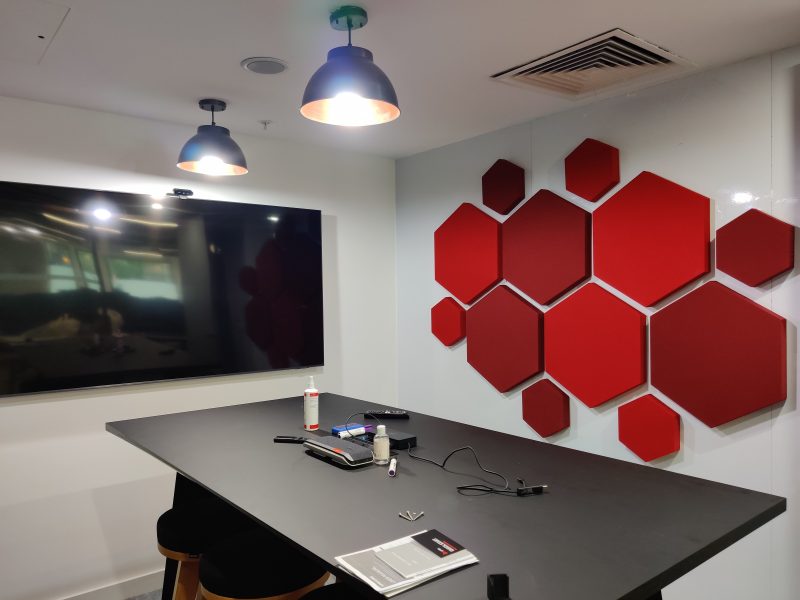
Diffusion Plate
Ok, so I will use the term “diffusion” lightly here. You can purchase combo absorption/diffusion panels from most acoustic treatment companies. The panels combine absorption panels with a diffusion plate. When buying them from a company, they are computer generated and designed to address specific frequencies. But what if you wanted to DIY it?
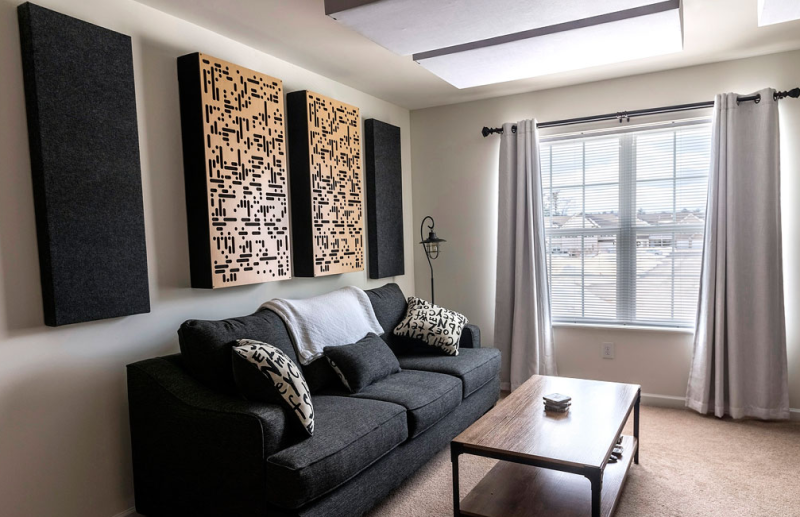
Well, Google and Pinterest are your friends here. I found some great ideas for making patterned plates for my acoustic panels. What did I settle on? I was walking through Home Depot and saw a resin lattice that was the exact dimension of my panels! So I picked up a few of them and put them on with some fancy screws, and bam, fancy treatments! And yes, I am still determining what frequency they are diffusing. But honestly, I have never found any difference in sound or room measurements before and after attaching them.
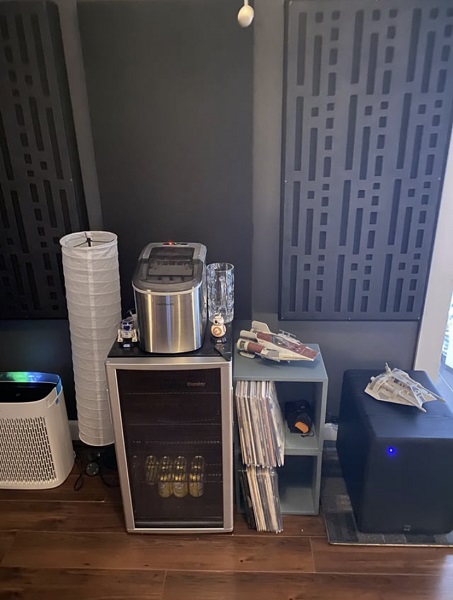
False Walls / Structures
This idea is not about blending room treatments with decor. Instead, it’s about making a wall or structures (columns, etc.) the room treatment. While this will be the most expensive option (framing, insulation, and a lot of fabric), it will hide your absorption and blend it into the wall.
I don’t want to get into the nitty gritty of false walls. Mostly because we already wrote that article. But to simplify it, a false wall is (generally) a stand-alone framed wall that conceals speakers and other gear. It is not structural, but it does allow you to stuff it full of rock wool and cover it in an acoustically transparent fabric and even a projection screen! Imagine an entire wall of insulation rather than a 2×4′ panel! And like the other examples, you can get colorful with fabrics, patterns, and the like. As long as air passes through freely, so will sound.
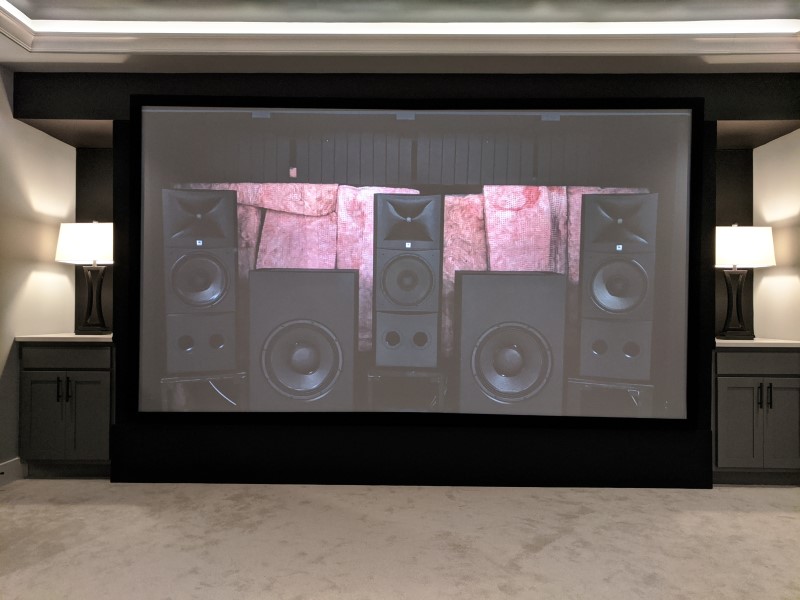
And I did say structures. Some basements have exposed support columns that hide in framing and gyprock. Imagine using rock wool and fabric over the columns. It’s an easy way to add more absorption into a room without adding a panel on a wall.
Our Take
Room absorption is a critical piece of any home theater. It helps you tame room modes and get the best results from your speakers/room correction. But most of us skip them because of the way they look. Hopefully, I have given you a few tips on how to blend room treatments into your space.



